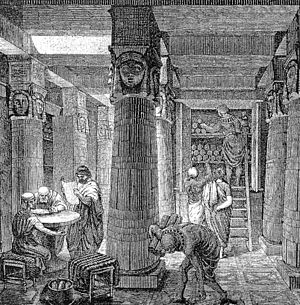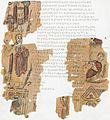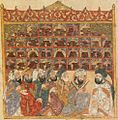Library of Alexandria facts for kids

The ancient Library of Alexandria was a very important and huge library in the old world. It was built in the city of Alexandria, Egypt. The library grew strong and became a big learning center thanks to the support of the Ptolemy family, who were the rulers of Egypt at that time. It was built around 300 BC.
In ancient Latin, people called the library the "ALEXANDRINA BYBLIOTHECE" (see image). The Greek word bibliotheke (βιβλιοθήκη) meant a collection of books, not necessarily a building. This makes its history a bit tricky to follow.
The library was thought up and opened either when Ptolemy I Soter was king or during the time of his son, Ptolemy II.
Contents
What happened to the Library?
Plutarch (who lived from 46 to 120 AD) wrote that Julius Caesar might have accidentally burned the library. This happened when Caesar visited Alexandria in 48 BC. He set fire to his own ships to stop Achillas from blocking his escape by sea. Plutarch said this fire spread to the docks and then to the library.
However, other writings from Caesar's time do not confirm this story. In fact, parts of the library's collection were destroyed many times. This happened both before and after the first century BC. A modern idea is that the library was destroyed by a Christian leader named Theophilus of Alexandria in 391 AD. He ordered the destruction of the Serapeum, which was like a "Daughter Library" and a temple to the god Serapis.
The Library as a learning center
The earliest information says that Demetrius of Phaleron first organized the library. He was a student of Aristotle. This happened during the rule of Ptolemy I Soter (who lived around 367–283 BC).
The library complex had a walking area, gardens, a dining room, and reading rooms. It also had lecture halls and meeting rooms. We don't know its exact layout. But this design might have influenced how university campuses are built today. The library also had a department for buying new books. It also had a department for making catalogs. The main hall had shelves for the collections of scrolls. Books at that time were written on papyrus scrolls. These collections were called bibliothekai (βιβλιοθῆκαι). It was said that a famous saying was carved above the shelves: The place of the cure of the soul.
This was the first known library to collect books from outside its own country. The Library was given the job of gathering all the world's knowledge. It did this in a very active way. The kings gave it a lot of money. They sent people to book fairs in places like Rhodes and Athens. They also had a rule to take books from every ship that came into the port. They kept the original texts. Then they made copies to send back to the owners.
Alexandria had a special port that connected the mainland to the Pharos island. This made it a great place for trade from both the East and West. Soon, Alexandria became a major international trading center. It also became the main producer of papyrus and, later, books.
The library was also home to many scholars from different countries. The library filled its shelves with new works in mathematics, astronomy, physics, natural history, and other subjects. It was at the Library of Alexandria that the scientific method was first developed and used. Its careful standards were used for serious textual criticism. This meant comparing different versions of the same text to make sure they were accurate. Once a text was checked, copies were made for scholars, royalty, and rich book collectors around the world. This trade also brought money to the library.
The editors at the Library of Alexandria were especially known for their work on Homer's texts. The most famous editors usually also held the title of head librarian. These included:
- Zenodotus (early 200s BC)
- Callimachus (early 200s BC), who created the first library catalog called the Pinakes.
- Apollonius of Rhodes (mid-200s BC)
- Eratosthenes (late 200s BC)
- Aristophanes of Byzantium (early 100s BC)
- Aristarchus of Samothrace (late 100s BC).
- Euclid.
The library's collection was already famous in the ancient world. It became even more legendary in later years. The collection was made of papyrus scrolls. Later, parchment codices (which were like early books) became more common after 300 BC.
A single piece of writing might fill several scrolls. King Ptolemy II (309–246 BC) is said to have aimed for 500,000 scrolls for the library. Mark Antony supposedly gave Cleopatra over 200,000 scrolls as a wedding gift. These scrolls were taken from the great Library of Pergamum. Carl Sagan, in his TV series Cosmos, said the library had almost one million scrolls. However, other experts think the number was smaller. No list of the library's books still exists. So, we cannot know for sure how big or how varied the collection was.
There is a story, perhaps a bit exaggerated, about how the library's collection grew so large. King Ptolemy III made a rule. All visitors to the city had to give up any books and scrolls they had. Official scribes would then quickly copy these writings. Some copies were so exact that the original texts were put into the library. The copies were then given back to the owners, who didn't know what had happened. This process also helped to build up a large collection of books in the relatively new city.
According to a writer named Galen, Ptolemy III asked the Athenians if he could borrow the original scripts of Aeschylus, Sophocles, and Euripides. The Athenians asked for a huge amount of fifteen talents as a guarantee. Ptolemy happily paid the fee but kept the original scripts for the library.
The modern Bibliotheca Alexandrina was opened in 2002. It is built near where the old library once stood.
Related pages
Images for kids
-
Bust excavated at the Villa of the Papyri depicting Ptolemy II Philadelphus, who is believed to have been the one to establish the Library as an actual institution, although plans for it may have been developed by his father Ptolemy I Soter
-
According to legend, the Syracusan inventor Archimedes invented the Archimedes' screw, a pump for transporting water, while studying at the Library of Alexandria.
-
The Roman general Julius Caesar was forced to set fire to his own ships during the Siege of Alexandria in 48 BC. Many ancient writers report that the fire spread and destroyed at least part of the Library of Alexandria's collections; however, the Library seems to have either at least partially survived or been quickly rebuilt.
-
Drawing from the Alexandrian World Chronicle depicting Pope Theophilus of Alexandria, gospel in hand, standing triumphantly atop the Serapeum in 391 AD
-
Interior of the modern Bibliotheca Alexandrina
See also
 In Spanish: Biblioteca de Alejandría para niños
In Spanish: Biblioteca de Alejandría para niños










